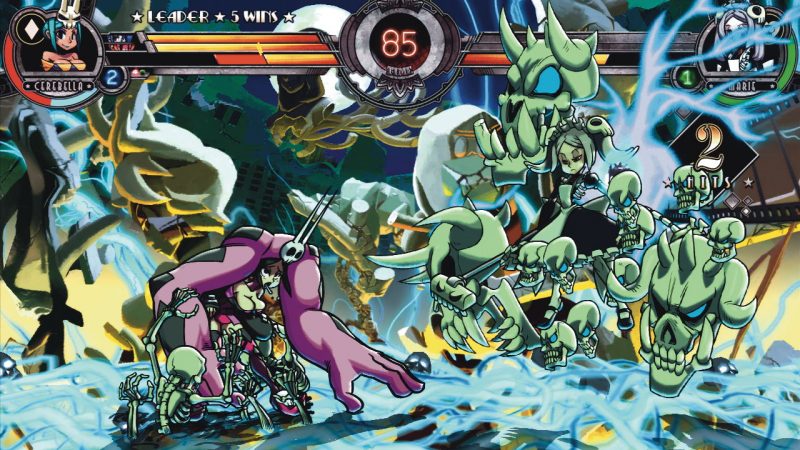Skullgirls (PSN/XBLA)

Skullgirls is the first fighting game ever made that wants you to play it like a fighting game. Most fighting games don’t care at all if you play them like a fighting game; they leave that to the people who have been playing them for decades. Some occasionally give a lazy, boring tutorial, asking you to press buttons every minute or so without explaining how they will ever become important, as if the game was an indescribably slow paced remake of Guitar Hero.
Fighting games are beautiful to watch and play, but they are made for people who are already good at fighting games. Skullgirls is too, but the difference is Skullgirls does not ignore or placate new players. It wants them to join the ranks of fighters. It’s a rare fighting game with a single player option that is actually fun, and maybe the only game that is interested in teaching you how to play it. These things may be related. Okay, these things are definitely related. Skullgirls is a fighting game for people who want to be good at fighting games, who want to live in that crazy violent dance.
The most single player fun Skullgirls has to offer is not found in the menu item named “single player”. Skullgirls’s single player story mode is serviceable but disjointed, loaded with the game’s dark, yet playfully and cartoony, artwork, and thin on story (and the beautifully animated boss is easily one of the most frustrating in fighting game history). No, the most fun to be had playing the game by oneself is in the tutorial. It’s in the tutorial because video games have this funny magic of being able to make learning how to do something as fun as actually doing it. Some of the best games ever teach you how to play them from your first steps without you even realizing that you’re being taught, and they keep teaching you how to play them until the very end.
Fighting games are built on piles and piles of very complicated but important mechanics that should at once be deep and engaging and fun and dramatic. But most fighting game single player modes seem to lack faith in themselves and their own mechanics, as if they don’t think that players are willing, interested, or capable of engaging with the game system. That further widens the gap between fighting game community and the rest of those who play games. There are dozens of online sites dedicated to teaching people how to play fighters, but none of this ever makes it to the games. It’s more effective and so much more fun to learn by doing rather than watching Youtube.

Skullgirls has enough confidence to teach players real, practical information. And here’s the thing: doing these things is fun! Mixing up high and low attacks to trick your opponent into blocking incorrectly is fun. Dashing through the air like a violent bumblebee is fun. Even figuring out the precise rhythm of correct blocking is fun (maybe even the most fun). Learning (and, more importantly, doing) all those little things are really, really fun, and Skullgirls tests you on trickier and trickier stuff until you get it, which is fun in and of itself and would form the backbone of any single player game. Most fighting games would never teach you how much fun all of this stuff was, as if pressing random and incomprehensible buttons was inherently fun. It isn’t; fighting the computer or other human beings tends to be extremely frustrating when you don’t know what you’re doing. Still, Skullgirls doesn’t quite find a way to lead players gently into actual play; it’s either piecemeal tutorial or full on confrontation, but the attempt is there and better than anything that’s come before.
The tutorial alone is worthwhile, but the game itself contains a level of polish and visual beauty absurd for a downloadable game, with animation that far exceeds that found in many retail games with 2D graphics. The visual style is equally cute and evil—drawing from Capcom’s disturbing and surprisingly comedic late 90s fighter Darkstalkers and the glam-rock chaos of Arc System Work’s Guilty Gear. A tiny bit Tim Burton, a great deal of Looney Toons, and quite a bit of anime, lead artist Alex Ahad’s art style is sexy and cute and sometimes more than a little disturbing. It’s a perfect mix for the diverse cast that makes the combatants as fun to look at as play. Fighting games have always suffered from weak stories, but they are frequently responsible for great characters, and Skullgirls echoes the absurd diversity found in their most colorful entries. Skullgirls include Filia, schoolgirl home to a monstrous parasite made of hair, Parasoul, who fences with a umbrella that weeps tears of napalm. There’s also Peacock, who fights with a cacophony of pop-culture references, including, but not limited to, Tex Avery cartoons, Japanese memes, old fighting games, and the refrigerator from Requiem For a Dream. The animation is more fluid than the cartoons Skullgirls pays homage to, and excellent (and funny) voice acting cements the characters.
-

-

-

-

-

-

-

-

-

-

-

-

-

-

-

-

-

-

-

-

-

-

-

-

-

-

-

-

-

-

-

-

-

-

-

-

-

-

-

-








































